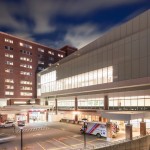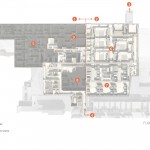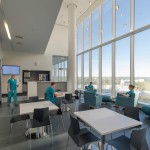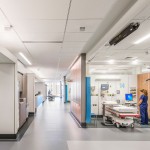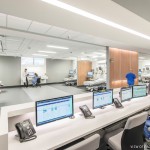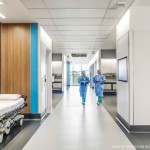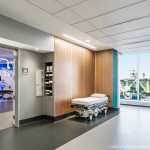Surgery 2 Expansion
Project Name
The project is an addition to an existing building on a hospital campus with buildings dating to the 1870s. The project program includes five operating rooms and 20 prep and recovery bays that expand on adjacent programs.
Though the plan is dense and functionally driven, it was critical to utilize views and daylight as organizing elements. Traditionally operating rooms and recovery beds are located in the basements of facilities. With this, facilities for families and loved ones are also located in basement quality spaces. For this project it was critical to embrace the site and connect to the exterior. Full-height glass at the end of passageways and strategic placement of interior glazing brings light into the space. Circulation is placed at the perimeter of the building to maximize the number of occupants who may enjoy access to daylight. Use of interior glazing borrows light and view to areas that have an intervening space at the perimeter, regardless of the program of that space. Clerestory windows in the prep/recovery area maintain patient privacy while allowing the essence of daylight to travel through the space.
The building envelope is designed to reduce the apparent mass of the building by creating a reflective and translucent skin that is more atmospheric than earthy. Despite being a continuous curtain wall skin, less than 20% of the skin is vision glass allowing for a thermally responsive envelope to the climate. The remainder is insulated spandrel panel. All vision glass in the envelope has a ceramic frit, which will mitigate solar gain and glare. Additionally, the fritting and spandrel glass are strategies that help prevent bird strikes on the glass building and maintain a level of privacy for patients on the exterior
The lighting strategy is one of reinforcing architectural elements while providing safe and effective illumination for clinical use. Fixtures are organized as continuous lines of light, with focused light as needed to wash vertical surfaces. Sliding planes of wood in prep/recovery are illuminated from a hidden slot. The restricted corridor and operating room entries are lit indirectly with continuous linear wall-washers that highlight wood and colored panels. A slot of color adjustable LED lights in each OR allow for surgeon to look up and reduce eye strain during a procedure. In all spaces, particular attention is focused on creating a pleasant patient and family experience despite the obvious seriousness of the use of this facility.

